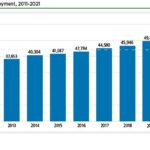Slovenia
European Space Industry Employment, 2011-2021


European space employment was 53,051 in 2021, an increase of 5.4% from the total of 50,317 from 2020. This estimate is based on analysis by Eurospace, the trade association of the European Space Industry. The analysis focuses on the space manufacturing industry; space services companies such as Ariane- space, SES, Eutelsat, and Inmarsat which also employ thousands of individuals, are not included.
Europe Continues to Lead in Global Workforce Job Growth


The space industry relies on skilled individuals from a wide variety of fields to enable the cutting-edge developments taking place in this sector. While many countries do not regularly produce metrics on the size of their workforce, these data are available for several major space actors, including the United States, Europe, Japan, and India.
2019 TSRQ3 – Education STEM Proficiency


The science, technology, engineering, and mathematics (STEM) workforce is at the core of the space industry—from the mathematicians and astronomers who analyze space to the engineers who design and build the launch vehicles that get us there. This workforce is enabled . . .
2017 – Government Space Budgets
Global government spending increased in 2017, totaling $76.2 billion, up from $72.7 billion in 2016. Government spending accounted for 19.9% of the global space economy . . .